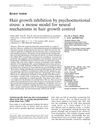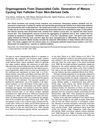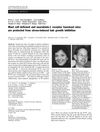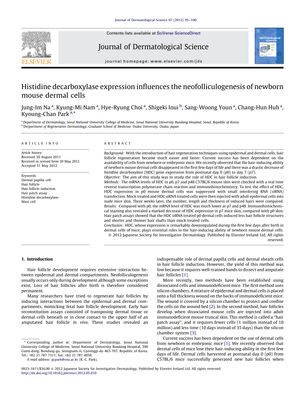TLDR The gene HDC is important for the development of hair follicles in newborn mice.
The study from 2012 examined the influence of histidine decarboxylase (HDC) on hair follicle development in newborn mice. It was found that HDC gene expression in dermal cells from C57BL/6 mice significantly decreased from the day of birth (p0) to seven days after birth (p7), which corresponded with a reduced capacity of these cells to induce hair follicles. By suppressing HDC expression in p0 dermal cells using small interfering RNA (siRNA) and then injecting these cells with adult epidermal cells into nude mice, it was observed that the treated dermal cells led to the formation of fewer and smaller hair follicle structures, as well as shorter and thinner hair shafts, compared to mock treated cells. This suggests that HDC plays a crucial role in the hair-inducing ability of dermal cells shortly after birth.
 321 citations
,
December 2009 in “Journal of Dermatological Science”
321 citations
,
December 2009 in “Journal of Dermatological Science” Dermal cells are key in controlling hair growth and could potentially be used in hair loss treatments, but more research is needed to improve hair regeneration methods.
 127 citations
,
December 2005 in “Experimental Dermatology”
127 citations
,
December 2005 in “Experimental Dermatology” Stress can stop hair growth in mice, and treatments can reverse this effect.
 205 citations
,
April 2005 in “Journal of Investigative Dermatology”
205 citations
,
April 2005 in “Journal of Investigative Dermatology” Scientists have found a way to create hair follicles from skin cells of newborn mice, which can grow and cycle naturally when injected into adult mouse skin.
 76 citations
,
March 2005 in “Journal of Molecular Medicine”
76 citations
,
March 2005 in “Journal of Molecular Medicine” Certain mice without specific receptors or mast cells don't lose hair from stress.
154 citations
,
October 1996 in “Proceedings of the National Academy of Sciences of the United States of America” Estrogen affects hair growth and skin cell multiplication.
21 citations
,
December 1994 in “British Journal of Dermatology” Sheep dermal papillae can help form hair follicles in skin models.
125 citations
,
August 1992 in “Development” Implanted dermal papillae can induce hair growth in rat ear wounds.
65 citations
,
October 1988 in “Clinics in dermatology” The dermal papilla interacts with the epidermis to control hair growth and development.




